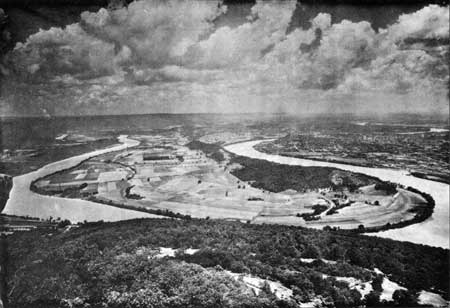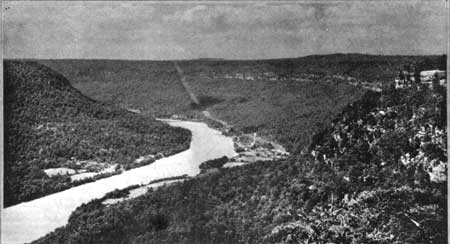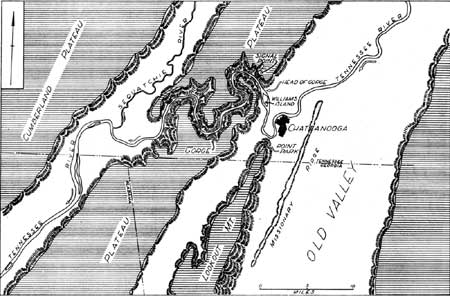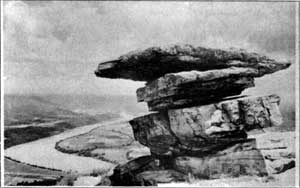|
STOLEN WATERS - IN TENNESSEE
By Harry S. Ladd,
Regional Geologist,
Richmond, Virginia.
Through his long association with rivers, man has
endowed them with many personal traits. To some primitive peoples rivers
are gods to be feared, to others they are gods to be worshiped. The
Hindus, for example, firmly believe in the healing powers of the filthy
Ganges. To the American Negro our Father of Waters is more human than
god-like. The Negro speaks of him affectionately as "Ole Man River" yet
pleads with him to "stay away from my door!" In point of fact, the
analogies are not far fetched for some rivers do have personal traits
that ally them with many human beings and some of the lesser gods.
Powerful streams are ambitious and single-minded. They wage a ceaseless
battle with the land that supports them, trying constantly to reduce it.
They even fight among themselves for this privilege. A stream that is
more powerful than its neighbor may cut down a divide and divert a
portion of the neighboring stream itself. Such a stream is called a
pirate and the unfortunate stream that loses a part of its drainage
basin is said to have been beheaded.
Many cases of stream piracy have been recognized and
described for it is well nigh impossible for the pirate stream to
obliterate all evidence of the crime. Once of the most famous cases
involves the Tennessee River in the vicinity of Chattanooga and it is
our purpose to describe this case briefly. We might mention in passing,
that the steal took place in early prehistoric times, that no accusation
was made until the year 1894 and that the trial (conducted by
geologists!) has been going on ever since. Evidence recently uncovered
by geologists of the Tennessee Valley Authority leads us to suspect that
a verdict of guilty will shortly be brought in.

THE TENNESSEE VALLEY ABOVE ITS GORGE
View from Point Park at Northern End of Lookout Mountain
An excellent view of the scene of the crime can be
obtained from the northern end of Lookout Mountain, in Chickamauga and
Chattanooga National Military Park. Doubtless many thousands of visitors
have clicked their shutters with satisfaction as they recorded the view
shown on the opposite page. We see the river meandering toward us in
broad curves on its wide valley floor until it washes the foot of
Lookout Mountain. Beyond the bend in the right foreground lies the City
of Chattanooga. Beyond the city, portions of other broad meanders can be
seen. In the left side of the photograph the stream takes another broad
curve, divides to enclose Williams Island and reaches the head of its
gorge. It should be pointed out that this part of the valley is
comparatively old. For countless years the stream has shifted its course
from side to side, wearing back its valley walls to produce the wide
flat.
As the river enters its gorge the character of the
valley changes completely. It abandons the wide open valley that it has
been following southwestward for 75 miles. It makes a right angle turn
to enter a comparatively narrow gorge whose walls rise upward for a
thousand feet.

Gorge of the Tennessee as Seen from
Signal Point, a Part of Chickamauga and Chattanooga National Military
Park
This, says the prosecution, is an anomalous course.
Why, they ask, should the river abandon the wide valley that continues
southwestward and is eventually occupied by the Coosa River? Why should
it leave the easy grade of the old established valley to enter a
youthful gorge cut in solid rock? We shall return to this question in a
moment. First let us follow the river itself.
For twenty miles the stream twists and turns between
its rocky walls (see sketch map opposite), at last reaching Sequatchie
valley which, it should be noted, is an open valley similar to the one
that the river abandoned near Chattanooga. This second open valley
parallels the first and the Tennessee follows it southwestward for 60
miles.

SKETCH MAP SHOWING PRESENT DRAINAGE CONDITIONS NEAR CHATTANOOGA
and a Portion of the Old Valley Abandoned by the Tennessee
(click on image for an enlargement in a new window)
If the significance of the evidence presented is not
entirely clear to the jury, it may become so if we proceed to re-enact
the crime. There was a time, says the prosecution, when the ancestral
Tennessee did not détour through its present gorge. It
flowed serenely southwestward to the sea--past Missionary Ridge and
Lookout Mountain, to join the stream that we now call the Coosa. Its
course was comparatively straight and all parts of its valley were
equally well developed.
Nearly twenty miles to the northwest the Sequatchie
likewise flowed southwestward in an open valley comparable to that of
the ancestral Tennessee. (See sketch map) . The Sequatchie, however,
flowed along at a somewhat lower level. Between these two parallel
streams rose a high, unbroken plateau. The prosecution claims that at an
early date a west-flowing tributary to the Sequatchie began to cut a
narrow gorge into the high plateau. Slowly it cut its channel downward
and extended its headwaters eastward. It is claimed that the power of
this stream was increased by a warping of the earth's surface. Finally
the tributary cut through the plateau and tapped the waters of the
Tennessee. Since its valley offered a quicker escape to a lower level,
the Tennessee was diverted to its present tortuous course through the
newly made gorge. The old valley south of the point of diversion was
left with but a trickle of water flowing southwestward to the Coosa.
The early prosecutors built up a strong case against
the pirate. They cited other types of evidence in addition to that
mentioned above. Many, including writers of conservative geological text
books, believed that the pirate was guilty. The lawyers for the
defendant, however, dug up new evidence and appealed the case. They
built up an alternative explanation that sounded very plausible to many
readers. They contended that the gorge and the open valleys above and
below it were carved by the streams that now occupy them. Differences in
age, they said, are more apparent than real. The gorge is just as old as
the open valleys. Its walls are steep and its floor narrow because it is
cut in rocks that are harder and more resistant than the rocks of the
open valleys. They likewise attacked the other types of evidence offered
by the prosecution but all these arguments cannot be reviewed here. They
rested their case, having won many supporters, -- having, in fact,
successfully hung the jury!

Hard Sandstone Cap the Plateau through which the
Pirate Stream Cut its Gorge
|
For a long time there were no new developments and it
seemed that the case might never again be brought to trial. Finally,
however, some important new evidence was uncovered in a wholly
unexpected quarter. The TVA began extensive geological explorations in
the valley of the Tennessee River. A part of this work consisted in
putting down an enormous number of borings, drill-holes and test pits on
numerous potential dam sites (1). Some of these sites lay in the open
valleys previously referred to -- that of the Sequatchie and that of the
Tennessee near Chattanooga. Drill holes in these areas revealed ancient
channels and solution levels 100 feet below the present river bed. In
connection with the controversy over piracy the discovery of these
solution caverns was interesting but not particularly significant until
holes had been put down on the site of the Hales Bar Dam in the gorge
itself. At this site, though the river is running over the most soluble
of all the limestones of the area and though the immediate bed is
literally honey-combed by solution, no very deep solution cavities were
found. Remembering that underground caverns are formed slowly by
solution it would appear that the open valleys above and below the gorge
actually are appreciably older than the gorge itself. The distribution
of the solution cavities does not offer conclusive proof of piracy but,
as Mr. Eckel states (2), it is highly suggestive. It appears to us to be
the most damning bit of testimony yet offered against the pirate.
(1) All information covering TVA
activities is taken with the permission of Edwin C. Eckel, Chief
Geologist, TVA, from his mimeographed bulletin, Geological Work of
the Tennessee Valley Authority, issued in 1936.
(2) Personal communication, 9,
1939.
| 
